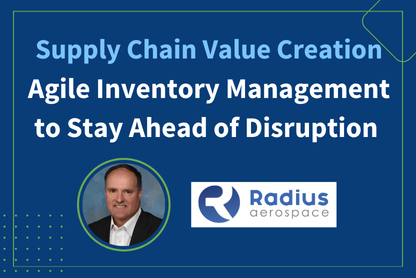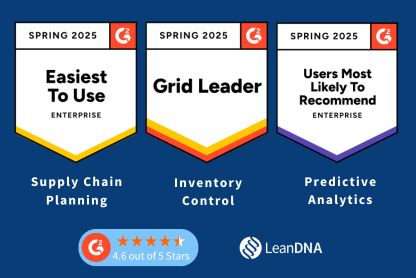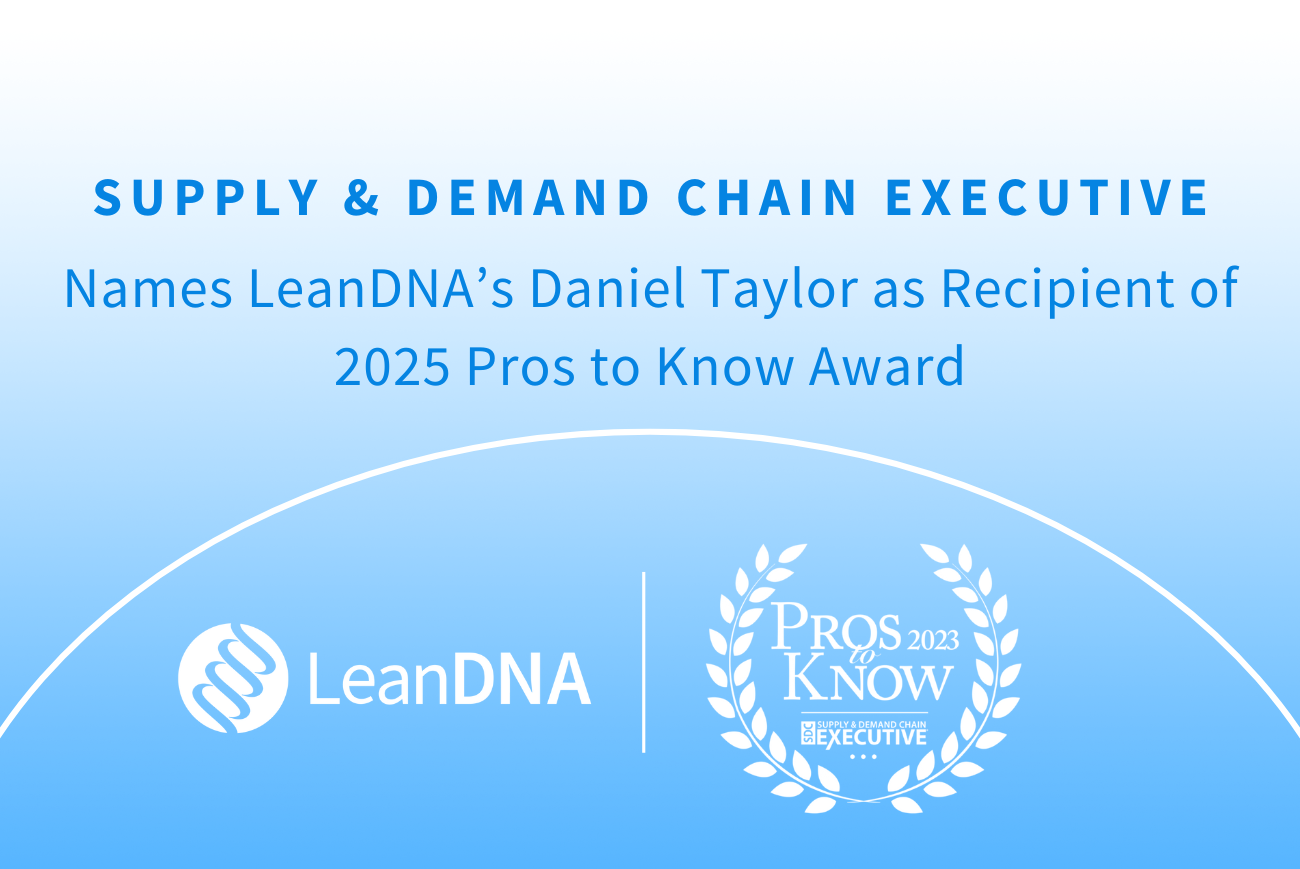In IndustryWeek’s recent webinar, “Going Beyond Status Quo,” we brought together leading supply chain experts to introduce a new hybrid inventory management model for today’s manufacturing complexities. Richard Lebovitz, Paul Aram, and Bob Ferrari have mastered this model, which leverages the best of lean procurement while maintaining an MRP-driven PO-based forecast. They shared their expertise on how to deploy it and why it’s more important than ever.
We’ll do a deep dive into the new inventory management model in our next blog, but for those who tuned in to the live webinar (or listened to the recording), there were some important questions and takeaways made by the audience. Read the most popular questions and answers from the experts below.
What is the first step we can take towards digital transformation in the supply chain?
Look at all of the non-value added activities. And trust me, there's a lot of it: Looking at MRP, raising purchase orders, and acting and responding to messages are not value-add activities. What is value-add is looking forward and predicting problems, and acting on exceptions.
The first step I would do is to take a look at what your teams are actually doing, some value stream mapping or something similar to that. Look at all the non-value-added activity you're doing, then look at various ways that you can replace that with more automated processes.
Then, there's various ways you can automate processes.. For example, there are established ways to communicate with suppliers and automatically get demand for them, whether it's schedule sharing, VMI-type processes, or anything like that. Anything that you can do that will automate the process.
The other big thing is automating the sort of production planning process of the front end; this is the bit that people often forget. You have these teams of people who are taking demands, you're running MRP, you’re creating work, or you're trying to allocate stock to it. There are mechanisms we’ve done at Ingersoll Rand where you automate that whole process. The demand is coming in, going through some algorithms, or the model is literally going in real-time to the production line. You're eliminating all of the wasted time that happens in the middle.
—Paul Aram, Vice President of Global Operations, Ingersoll Rand
When do you foresee us coming out of the current shortage storm that all manufacturers seem to be currently dealing with?
Everything I'm seeing right now indicates that we're going to be in this shortage storm for the rest of 2021.
There was a huge response from the global supply chain based on the demand change that occurred at midpoint last year with COVID, and new product demands for certain products. Then, a complete inventory replenishment cycle. So we had a tidal wave of materials that were inbound to many global regions. Then we had, as we described in this webinar, the “Perfect Storm” of all these disruptions, and Suez Canal which led to the supply disruptions.
One disruption is causing another. There's only so much capacity right now, and for the semiconductor makers to come forward with new capacity, it's going to take two to three years. With so much of that new capacity now coming online, there's already concerns about if production equipment providers can respond to those inadequate lead times. There are other notions about whether shortages will cause other shortages among manufacturers. So, it cascades.
The bottom line here is that realistically, we're going to go through the bulk of this year with a lot of these types of disruptions, unfortunately, and supply chain teams are going to have to just be able to respond to them.
—Bob Ferrari, Founder and Managing Director, Ferrari Consulting and Research Group
For large enterprises with a combination of make-to -stock and configure-to-order products, what tools should they leverage first?
It depends on what your objectives are. Over the years, I’ve found that at a lot of operations, people are tasked with reducing inventory and internally facing things. For me, my recommendation is look at it that way. You want to be looking at what sort of full month, or customer service proposition you want to be giving to your customers. What do you need to be doing, and let all your other activity flow down from that.
For me, I would copy what we've done, which is to divide your products into these sort of standard configured and engineer's categories, decide what the service definition needs to be for each of those, find your factory capacity, and then your inventory levels that you need to put in place to be able to support that and the replenishment capability.
—Paul Aram, Vice President of Global Operations, Ingersoll Rand
How does the software work when a company struggles with basic data accuracy like Inventory Management and/or Bills of Material?
This is a great question, and one our team receives often when manufacturers are considering bringing LeanDNA into their organization. Typically, even poor data gives good insights about the actions needed to ensure your supply chain is working correctly; no one has perfect data, and the only way to move forward is continuously improving it.
Here's how LeanDNA helps do that:
- LeanDNA has pre-built connectors with most, if not all, ERP systems. Once the data is consolidated in LeanDNA, it is harmonized so that data is all defined and surfaced in the same way.
- During implementation, the LeanDNA Customer Success and Value Engineering teams will help review the data to see which gaps are the most important to focus on first. For example, we may need to ensure all parts have proper supplier mapping, or order policies, or lead times, in order to ensure LeanDNA's algorithms will work correctly.
- Once teams can SEE where their data accuracy issues are in our dynamic dashboards, our customers can quickly identify where inventory KPIs are off, allowing them to tackle the issues and fix them as a one standardized team. Collaboration is available within LeanDNA to help distribute actions to the appropriate teams to help correct data; LeanDNA will recalculate the next day and if the data was updated, the actions will also update accordingly.
—Daniel Taylor, Director of Customer Success and Solutions Engineering, LeanDNA
Beside ERP applications, how do you manage the whole management collaboration (working together) in responsive decision making?
Building an environment ready to rapidly respond and make decisions requires a single source of trusted information. In today’s complex environment, it is virtually impossible to collaborate through emails and spreadsheets. We strongly believe it has to be virtual, validated, and updated frequently. Without a cloud-based solution to host data and information in the same standardized way across sites and ERP systems, any collaboration or processes set in motion will be hard to achieve and scale.
In addition to putting data in one place, we recommend finding a way to have the collaboration in the same place as well. Foster an environment where teams can comment and give status updates virtually. This not only helps drive in-person (or online conversations) about current situations and challenges, but it also builds continuity and historical context for data points or actions.
And last, help teams make decisions by automating a lot of the manual processes. Provide buyers, analysts, and supply chain managers with automated reports and root cause analysis (maybe even prescriptive recommendations) so they can spend their valuable time on taking action and collaborating with their teams vs. massaging data in excel and building their own standard reports.
Once everyone is in the same place, teams can be truly agile—responding quickly and working together to mitigate new challenges as they come.
—Daniel Taylor, Director of Customer Success and Solutions Engineering, LeanDNA
What’s the most practical means for a small enterprise to approach or implement this? It sounds like a process that’s very time intensive, or one that seeks to manage resources certain shops just don’t have. How do I determine if looking that far out is even feasible for my business?
The process of establishing a hybrid model can feel daunting at first, but typically ends up being less time-intensive and resource-heavy than a typical ERP implementation or switchover; or the process of deploying on a new end-to-end solution. We always say keep it simple, implement in phases, and focus on results:
- Gain executive buy-in. Highlight the need for a more productive method to manage the complexity of inventory management, and focus heavy on the savings available by optimizing factory operations management (We can help you tell this story).
- Identify a team who will live and breathe the new process. They will become the super champions who will encourage their peers and teams to accept the change, new processes, and new technology.
- Start with a few target sites, build excitement and use this momentum to drive large scale operational transformation If your data has some issues, leverage these initial deployments to establish trusted data with your existing business systems. Get it all in one place, select a few KPIs and work on fixing those first. If you want to roll out a new process, implement and perfect these changes at the initial sites first, validate the results, and then leverage these changes across the enterprise.
- Leverage SaaS technology for quick deployment, standardized best practices, and easy collaboration across teams, sites, and your suppliers. With the complexities today, they need the most help with automating their processes and prescribing recommendations on how to keep your operation lean and productive. If you don’t have the resources to focus there, that’s okay too. Start building the processes, prove out ROI, and make the business case for a technology after 6 months.
It all comes down to changing the processes, which can feel overwhelming at first. Start small, and read more best practices for optimizing your workflows to learn more.
—Richard Lebovitz, CEO and Founder, LeanDNA
Is there an ideal percentage/ratio to “buffer” inventories?
If you're talking about the buffer percentage/ratio for an individual part, the answer will be specific to your business goals. Are you trying to optimize for excess inventory or to ensure you are preventing shortages?
If you're asking about which percentage of your parts to focus on buffer stock, that is also a complicated question. You may want to buffer ALL your parts depending on how your business operates. But if you just want to know which parts to focus on for optimal effect, you may just want to focus on your 'A' parts. We’re happy to work with you and your team to discuss your objectives and find the right balance for your organization, just reach out to our team and we’ll get a call set up.
—Brian Graham, Senior Solutions Engineer, LeanDNA
You keep describing this as a perfect storm. What if this is the new normal?
Right now, this may feel like a “perfect storm” for manufacturers, but this question is really getting to the core of the issue: This “new” normal is also the past and future normal. Constant disruption and change is normal for supply chains, and it will only grow more volatile as customers demand more, product complexity increases, and supply chains grow more global and vulnerable. In Lean Manufacturing, we plan for plans to fail. That’s what keeps business agile: The visibility, processes, and information needed to identify alternate suppliers, prevent critical shortages before they impact the operation, and continuously optimize inventory management—especially when things don’t go as planned.
As another attendee noted in their question, climate change and supply chains are deeply connected. We know this disruption is coming unfortunately, just like we know there will be more hurricanes and unexpected events like the Ever Given blockage at the Suez Canal. The path to supply chain resilience depends on agile factory operations, defined by having total visibility of inventory management data, role-based workflows to standardize productive work, and automated recommendations and analysis to help procurement leaders make the best decisions as soon as they need to.
—Richard Lebovitz, CEO and Founder, LeanDNA
Looking for more information? Watch the full webinar to learn why status quo inventory management isn't cutting it anymore, and how to implement the next generation model.



